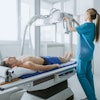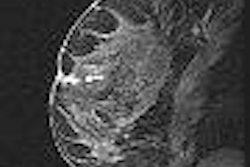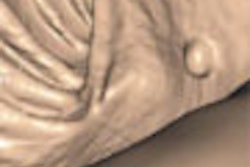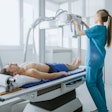In the never-ending quest for better presurgical information, researchers appear to be looking high and low. High tech and low tech, that is, in a pair of studies that range from testing investigational software for 3D glenoid measurements to simply checking which x-ray views elicit a greater consensus on greater tuberosity treatment.
The first study, anchored by Dr. Joseph P. Iannotti, co-director of the Orthopaedic Research Center and chairman of the orthopaedic surgery department at the Cleveland Clinic in Ohio, appeared in the Journal of Shoulder and Elbow Surgery (January/February 2005, Vol. 14:1, pp. 85-90).
Iannotti and his co-authors note that accurately evaluating the glenoid prior to surgery, including the amount of bone loss, helps in the success of total shoulder arthroplasty. While many cases can be adequately evaluated with standard x-rays, more complicated cases warrant CT imaging.
But, the authors wrote, CT can fall short of desired utility in two ways: 1) the scanner gantry angle relative to the scapula can significantly affect the evaluation of the glenoid version angle, and 2) the 3D geometry of the glenoid and its pathologic changes must generally be inferred by qualitative assessment instead of being measured directly.
Doing a 3D reconstruction of standard CT images eliminates the first issue, the authors wrote. And to address the second issue, the authors sought to validate the glenoid morphometry measurements obtained using new software developed specifically for that purpose.
The researchers obtained 12 normal cadaver scapulae and measured the glenoid version angle, maximum glenoid length, and maximum glenoid width of each.
They then scanned the scapulae in a Volume Zoom scanner (Siemens Medical Solutions, Malvern, PA) in a supine position, obtaining axial images in 1-mm increments.
On the resulting 2D images, readers specified three landmarks (the inferior tip of the scapula body, the center of the glenoid surface, and the medial pole of the scapula) from which the specially developed software would generate its measurements. Those calculations were then compared with the direct measurements of the scapulae.
The CT software calculations showed excellent agreement with the direct measurements, the researchers found.
"Our data suggest that the 3D CT images can reflect the true anatomy of the glenoid accurately and can provide important information regarding the glenoid vault," the authors concluded. "As such, they may prove to be a useful tool during the preoperative evaluation for a total shoulder arthroplasty, particularly in patients with significant glenoid bone loss."
Routine use of 3D CT for this purpose will be limited by the lack of a software package, the authors noted, although institutions with ambition and talent might check out the open source application used in the study at www.osc.edu/VolSuite.
In the second study, anchored by orthopedist Dr. Evan Flatow of the Mount Sinai School of Medicine in New York City, the researchers noted that accurate assessment of the degree of displacement in greater tuberosity fractures is important because it can drive treatment decisions and outcomes (Journal of Bone and Joint Surgery, January 2005, Vol. 87:1, pp. 58-65).
Yet accurate radiographic assessment can be difficult, the authors noted, "because of small fragment sizes and superimposition of the fragment on the humeral heads."
The team examined the accuracy of displacement measurements made by experienced surgeons working from radiographs, compared with the known displacement set up in 12 cadaver subjects.
In addition, they sought to evaluate the influence of various radiographic views on surgical decision-making.
Tuberosity displacements in four different sizes (2, 5, 10, and 15 mm) were created in the cadavers. The subjects were then imaged with fluoroscopy after soft tissues were put back in place.
Six different fluoroscopy images were made of each displaced tuberosity: a standard anteroposterior (AP) view, a lateral outlet view, an axillary view, an AP view in external rotation or "gunslinger" view, and two standard AP views with 15 degrees of cephalad or caudal tilt.
The authors noted that the last two views aren't typically part of the protocol for such cases. Also, in an effort to standardize the magnification across all images, the fluoroscopy C-arm was always positioned flush with the shoulder.
The resulting 72 images were then presented to four attending orthopedic surgeons at Mount Sinai, two shoulder specialists, and two generalists. They were asked to measure the displacement on each image from the edge of the defect in the humeral head to the closest edge of the greater tuberosity.
In a random presentation of all images, the gunslinger view and the AP view with caudal tilt were the most accurate for assessing displacement, though not significantly so. But the accuracy of measurements in general was disappointing.
The range of error for all views was 5.1-6.5 mm -- an amount of "some concern," the authors wrote, given that all of the surgeons said they regarded displacement equal to or greater than 5 mm as the threshold for recommending open reduction and internal fixation surgery.
One possible explanation for the high error values was the decision to use a fluoroscopic mini C-arm to generate paper images, where standard x-ray imaging would have generated higher-quality images.
While the use of the fluoroscopy unit also resulted in slightly greater magnification than standard radiographs, the over- and underestimation errors found in the displacement measurements suggested little impact.
The surgeons were also presented with the series of four orthogonal images typically taken in tuberosity fractures (standard AP, outlet, axillary, and gunslinger) for each case.
"Unlike previous investigators, we found substantial agreement (kappa value, 0.71) among surgeons with regard to their recommendations for treatment of fractures on the basis of four sequential images," the authors wrote.
Overall, "using multiplane radiographic imaging that includes an anteroposterior view in external rotation (if it can be tolerated by the patient) in association with the standard trauma series of anteroposterior, outlet, and axillary views may improve the accuracy and reliability of diagnostic imaging," the researchers concluded.
By Tracie L. Thompson
AuntMinnie.com staff writer
July 29, 2005
Related Reading
MDCT, MRI competitive in some bone lesion applications, June 20, 2005
Enthesopathy on shoulder MRI may tag severity of rotator cuff tears, February 24, 2005
Shoulder finding may aid in detection of ankylosing spondylitis, November 15, 2004
Sonography offers predictors of SST tears, February 25, 2004
Boning up on humerus, clavicle, and AC joint positioning, February 18, 2003
Copyright © 2005 AuntMinnie.com



















